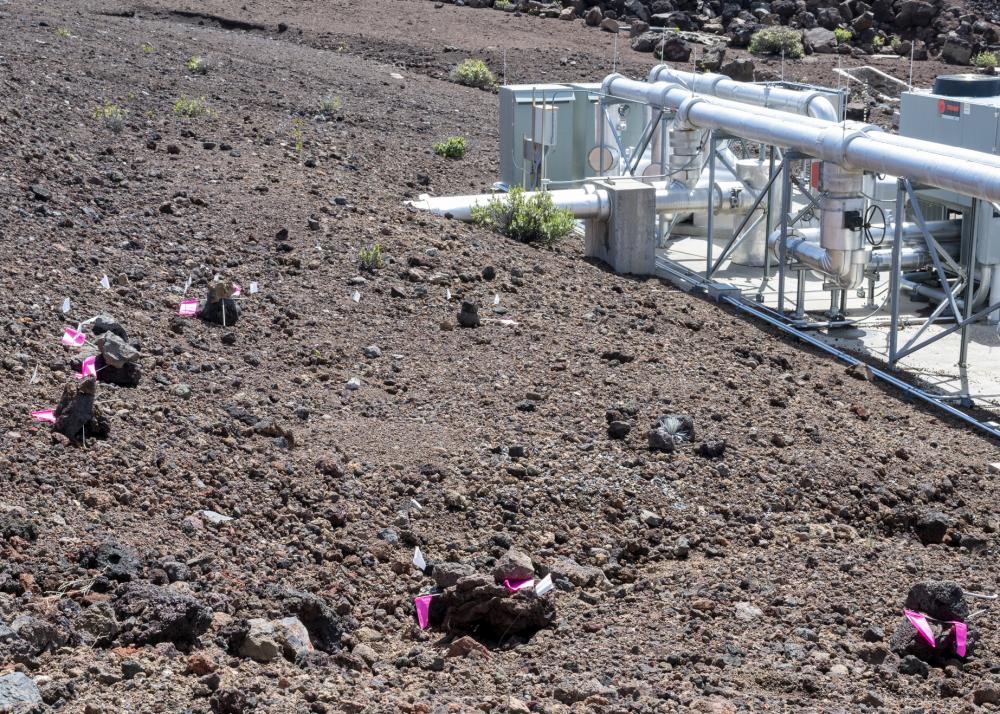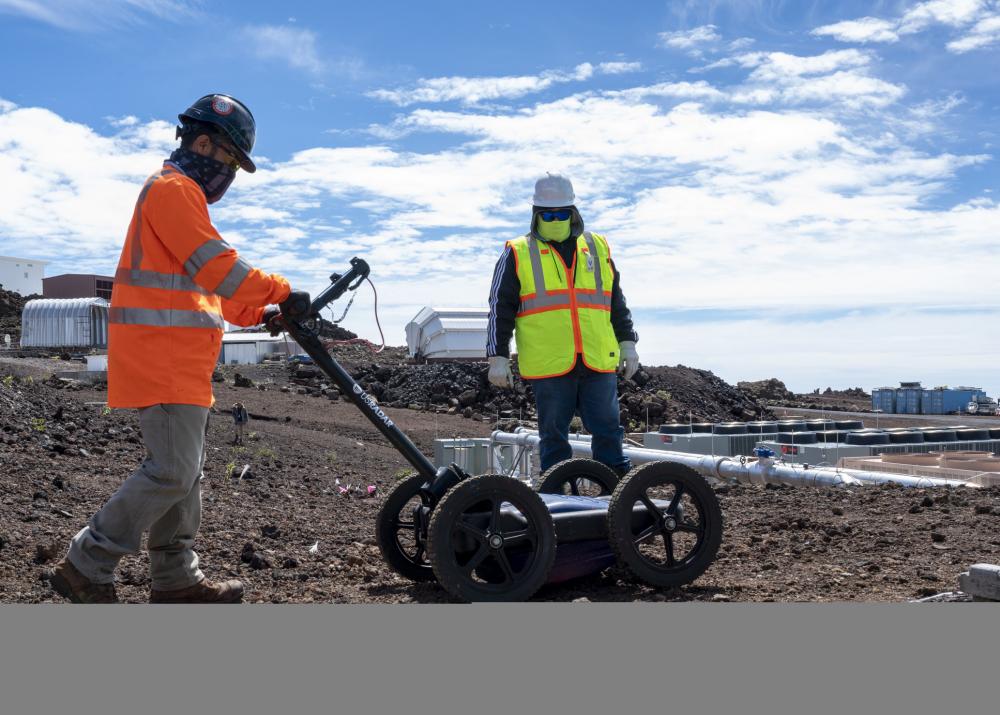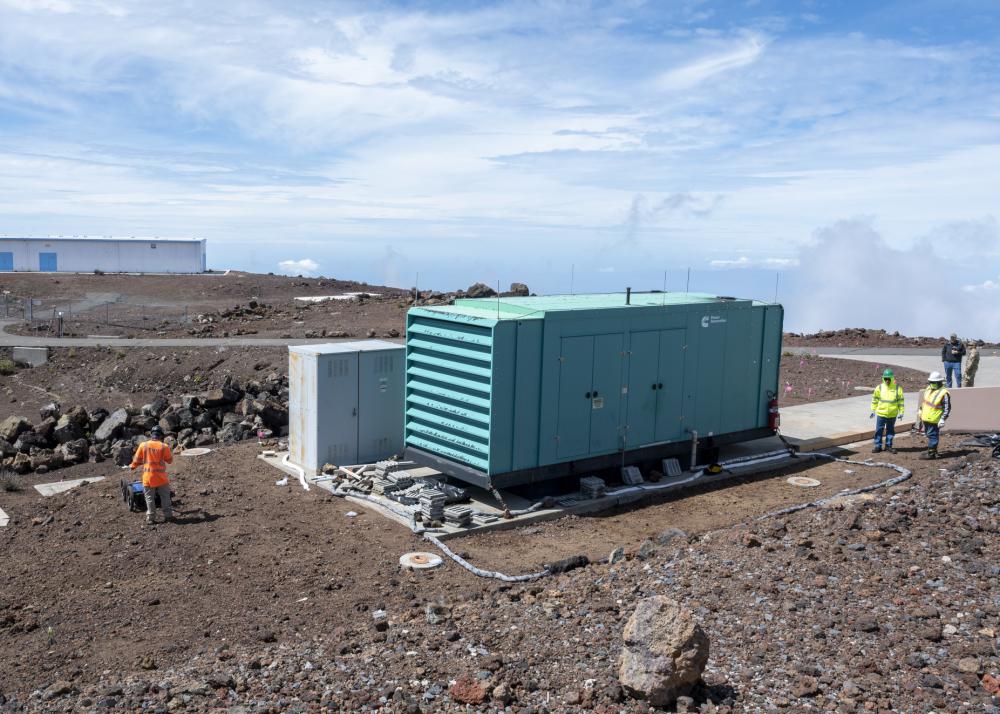Pentagon official embarrassed by Haleakalā fuel spill on Maui; contract secured for excavation

A contract has been secured to excavate the contaminated soil around a generator at the summit of Haleakalā where an estimated 700 gallons of diesel fuel spilled at the Maui Space Surveillance Complex late last month.
Pentagon official apologizes, embarrassed
Secretary of the Air Force Frank Kendall flew in from the Pentagon to speak at a Maui press conference held at the spill site within the Maui Space Surveillance Complex on Wednesday afternoon. He apologized for incident and said he was embarrassed by the fact that it occurred.
“Our response and notifications have moved with determined speed. We want to do this right. This incident hurts the environment, it harmed our reputation causing to question the trust placed in us by our local communities. To be clear, I apologize for what has happened, and this department will put our full sustained effort into repairing what has been done.”
–Secretary Kendall
Calling the incident “regrettable,” Secretary Kendall said every effort will be made to clean it up and make things right.
“Slow is smooth. Smooth is Fast.“
United States Space Forces Indo-Pacific Commander Brig. Gen. Anthony Mastalir joined Secretary Kendall at the briefing, saying a work plan is currently under review by the state Department of Health. He anticipates response from the DOH by today, at which point he said, crews would be ready for excavation.
ARTICLE CONTINUES BELOW AD“In the military we have a saying, ‘Slow is smooth. Smooth is fast.’ So when it comes to the cleanup of this sacred land, the best way to move fast is to slow down and make sure you do the job right–and we will do that with the people standing behind me today.”
–Brig. Gen. Mastalir
“We’re going to go as quickly as we can, but that means doing it right and taking our time to make sure it’s right,” said Secretary Kendall.
Top priorities: transparency, remediation, public trust
When Gen. Mastalir updated the community on Feb. 6, he stated this effort would be guided by three basic principles–promote openness and transparency throughout the process, deliver a remediation plan consistent with legal requirements and sensitive to local and cultural imperatives, and “earn public trust every single step of the way.”
“I share my support for these values,” said Secretary Kendall. “They will guide both our local responses and the larger path forward for the Department of the Air Force. Our ongoing response to this fuel spill is a top priority. That’s why I’m here today. Restoring the land and the trust will take deliberate, consistent action. We’ve built a strong team that’s drafting a reclamation plan that is in coordination with federal, state and local agencies, and local community groups.”
“This team does not work alone.”
Secretary Kendall said Hawaiian Electric has helped the Air Force restore the lightning protection devices that are on the site.
“In addition, state environmental officials have been receptive and have closely worked with us in our planning efforts as we begin the steps towards remediation. This team has accomplished a great deal in a short time, and it understands that their labors will continue until we restore the land,” he said.
Air Force officials say they’ve already compiled important lessons regarding the generator site which are being shared across the department of the Air Force to prevent future incidents like this from occurring.
“While we have fallen short of our own expectations, as stewards of this sacred place, I am fully optimistic we will be successful in remediating the entire spill on the land, in keeping our partners informed, while restoring the trust in community partners that they deserve.”
–Secretary Kendall
In addition to the DOH, the Air Force has been working with the Environmental Protection Agency – Region 9, US Fish and Wildlife Service, the University of Hawaiʻi Institute for Astronomy, the Hawaiʻi State Historic Preservation Division, and the Hawaiʻi Department of Land and Natural Resources Office of Conservation and Coastal Lands.
Teams mobilized for onsite inspections
Brig. Gen. Mastalir thanked both Governor Josh Green and Maui Mayor Richard Bissen Jr. for their commitment to both guiding efforts, and holding the Air Force accountable. “Their teams have promoted openness and transparency and have been true neighbors and teammates in this process.”
“The governor has asked us to go above and beyond, and so at Secretary Kendall’s direction, we have already begun to mobilize teams to conduct onsite inspections of generators at military installations across the state of Hawaiʻi,” he said.
“As our engineers and electricians meticulously reviewed hundreds of data points to better understand the unusual failure mode associated with the generator’s float and transfer pump assembly, we took immediate steps to share those findings widely,” said Brig. Gen. Mastalir.
The Space Force currently has six generators operating in the state of Hawaiʻi. “We have thoroughly checked out all six of those generators to make sure that they are operating in compliance, and that we don’t see any issues similar to what we have found here at Haleakalā,” he said.
Secretary Kendall said a review was conducted of how Space Forces responded.
“I think consulting with the Mayor immediately was very valuable to us. He gave us some good advice on how to proceed and interact with the community. I think that has paid off. I was able to give him my personal assurance that we were going to be on top of this and we are going to do everything we can… I’m very grateful again for his willingness to work with us to help us get through this as best as we possibly can,” said Secretary Kendall.
Community engagement, cultural monitoring
Brig. Gen. Mastalir said that given the cultural significance of Haleakalā, the Air Force made it a priority to hire an on site cultural monitor to bless the site and preside over meetings with key Hawaiian stakeholders throughout the process.
“Of course, along the way, our cultural advisor Dane Maxwell helped ensure that this project would not only meet the expectations of our regulators, but would meet the expectations of this local community (as well),” said Brig. Gen. Mastalir. He said Maxwell has been an integral part of what the Air Force is trying to accomplish–“full remediation with a cultural sensitivity that is due for this location.”
With the help and advice of Maxwell, Brig. Gen. Mastalir said the US Space Forces is exploring recurring community meetings to continue to answer questions residents may have as the remediation process gets underway.
Concurrent with the work of subject matter experts, Brig. Gen. Mastalir said teams have met with the community, trying to better understand what it is that they need to know about this area.
“We met with a group of about 60 student leaders at Kamehameha Schools Maui, and we met with members of the DKIST (Daniel K Inouye Solar Telescope) Native Hawaiian Working Group. We’ve even had meetings with lineal descendants of King Kamehameha himself. These meetings are important because we’re cultivating relationships and rebuilding trust–first by listening, and then by answering their questions directly and honestly,” he said.
“We’ve been asked many questions about the spill, but we’ve also been asked about the important mission that’s been conducted here at the Maui Space Surveillance Complex, and how the telescopes atop Haleakalā are used to constantly track and monitor activity in the space domain–protecting our nation’s most critical assets. It is a mission that greatly contributes to the defense of the Pacific Region and it is one of which all Hawaiians can be proud,” said Brig. Gen. Mastalir.
“From the beginning, my number one priority was to deliver a remediation plan consistent with legal requirements, and sensitive to local and cultural imperatives. There’s still much work to be done, but I’m immensely proud of the work that we have accomplished to this point,” he said.





















